PERENNIALS > NERINE
Chris is a gardening writer and nature enthusiast. He graduated from Oxford Brookes University in 2022 with an MA in Psychology. Chris works with the Leeds Green Action Society, helping their food cooperative by growing various fruit and vegetables on their two allotments in Hyde Park, Leeds.
Reviewed By COLIN SKELLY

Colin is a Horticulturist and Horticultural Consultant with experience in a range of practical and managerial roles across heritage, commercial and public horticulture. He holds the Royal Horticultural Society’s Master of Horticulture award and has a particular interest in horticultural ecology and naturalistic planting for habitat and climate resilience.
Contributions From CAROLINE STONE

Caroline is the Journal Editor of ‘Amaryllids’, The Nerine and Amaryllid Society’s own published journal. Having held this position for over 10 years, Caroline has organised Gold and Silver-Gilt Medal displays at the RHS Malvern Autumn Show - and even has a cultivar of Nerine named in her honour.

Nick oversees the Exbury Nerines collection at Exbury Gardens, which has been at the gardens since 1995. It is the largest private collection of nerines in the UK. As one of the owners of Exbury Gardens, Nick also has extensive knowledge about other plants and is a key contributor to the garden’s YouTube page.
IN THIS GUIDE
NERINE GUIDES
There are many types of flowers you can plant to add great colour and interest to your garden, but few are as incredible as the Guernsey lily.
The great thing about Guernsey lilies is that unlike a lot of other flower species, they’re able to easily withstand the harsh conditions of UK winters, so you don’t have to worry about them struggling to cope with colder temperatures and frost.
Guernsey lilies come in a variety of colours and are perfect for growing in your garden, in pots or using the cuttings as part of a display.
In this guide, we collaborate with a few respected nerine enthusiasts here in the UK:
- Caroline Stone – Journal Editor of ‘Amaryllids’, The Nerine and Amaryllid Society’s own published journal.
- Nick de Rothschild – Oversees the Exbury Nerines collection at Exbury Gardens.
“Nerines are such wonderful plants for the Autumn, providing bright colour to carry us into the winter,” says Caroline.
Overview
| Botanical Name | Nerine |
| Common Name(s) | Guernsey Lily |
| Plant Type | Perennial Flower |
| Native Area | South Africa |
| Hardiness Rating | H5 |
| Foliage | Linear leaves which show after flowering |
| Flowers | Lily-like pink flowers |
| When To Sow | March, April |
| Flowering Months | September, October, November, December |
Sunlight
Preferred
Full Sun
Exposure
Sheltered
Size
Height
0.1 – 0.5M
Spread
0 – 0.1M
Bloom Time
September – December
Soil
Preferred
Most Soil Types (Except Heavy Clay)
Moisture
Moist but Well Drained
pH
Any
Let’s start by looking at the origins of the flower.
Guernsey lilies, also known by their botanical name as ‘Nerine’ plants, are a type of flower that originates from South Africa.1Nerine. (n.d.-b). Kew Royal Botanic Gardens. Retrieved March 16, 2023, from https://powo.science.kew.org/taxon/urn:lsid:ipni.org:names:1561-1
Although they originate from South Africa, they have been cultivated on the island of Guernsey for more than 300 years, hence their name.2Nerine. (n.d.-c). Royal Horticultural Society. Retrieved March 16, 2023, from https://www.rhs.org.uk/plants/nerine
The genus Nerine, which Guernsey Lilies belong to, was first established in 1820 by Reverend William Herbert.3Nerines. (2009, September 18). The Northern Echo. Retrieved March 16, 2023, from https://www.thenorthernecho.co.uk/opinion/latest/4636850.nerines/
Habitat & Growing Conditions
Guernsey lilies are native to South Africa, which means they are best suited to a temperate climate and cannot cope with prolonged exposure to extreme heat or cold.

Knowing the conditions that Guernsey lilies grow in the wild is certainly useful when you’re growing your own.
They grow best when they’re not disturbed and can be grown in bunches, provided you provide adequate space between each bulb.
Guernsey Lily Varieties
The term ‘Guernsey Lily’ is often used to describe the various types of nerine plants, with the two most common being N. bowdenii and N. sarniensis.
Below is a description of both plants –
Nerine bowdenii

N. bowdenii is the first type of Guernsey lily and the variety that people most often think of when they hear the name.
It has distinctive bright pink flowers and does well in temperate climates.
N. sarniensis
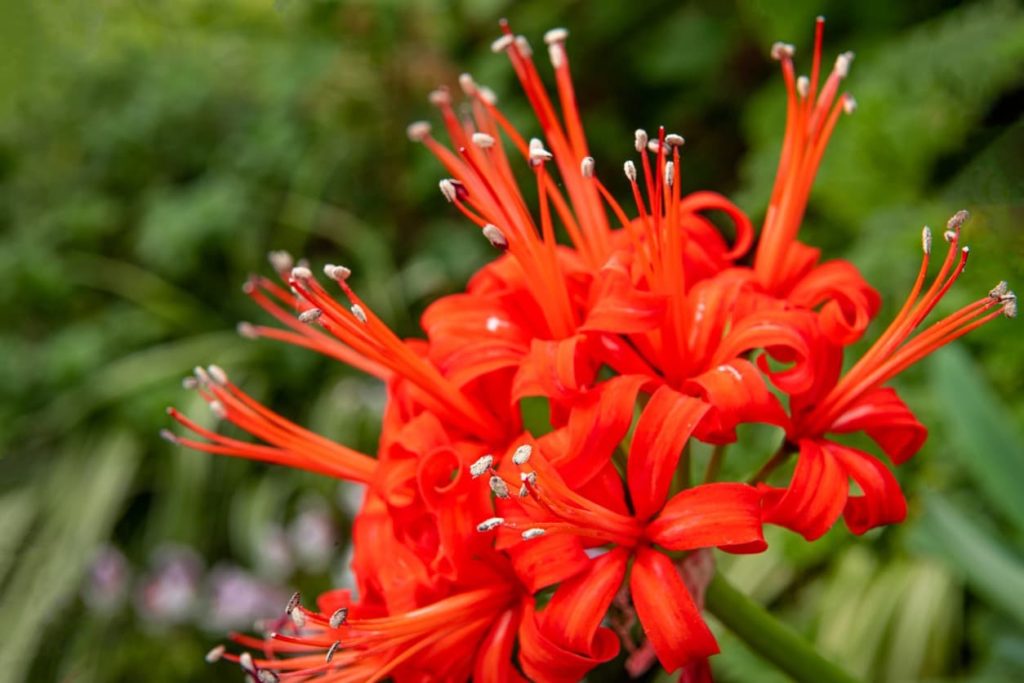
The other prominent type of Guernsey lily is N. sarniensis, which shares a lot of similarities with N. bowdenii, being suited to temperate climates.
The main visual difference between the two is the colour of their flowers, which are scarlet as opposed to pink.
N. sarniensis is also less hardy than N. bowdenii, requiring winter protection to survive.
“We have one of the finest collections of N. sarniensis in the world,” says Nick, when discussing his collection of nerines at Exbury Gardens.
“These nerines produce a wondrous spectacle in October that is just amazing to observe.”
Other Nerines
There are some other excellent plants in the Nerine genus that allow you to add a further range of colours to your garden.
“Increase the colour range of hardy nerines by growing several varieties,” says Caroline.
Her recommended varieties include:
- N. bowdenii ‘Isabel’
- N. bowdenii ‘Stefanie’
- N. bowdenii ‘Ella K’
- N. bowdenii ‘Bianca Perla’
- N. ‘Regina’
- N. ‘Wolsey’
- N. ‘Dingaan’
Below are some of the best ones to try:
N. bowdenii ‘Alba’
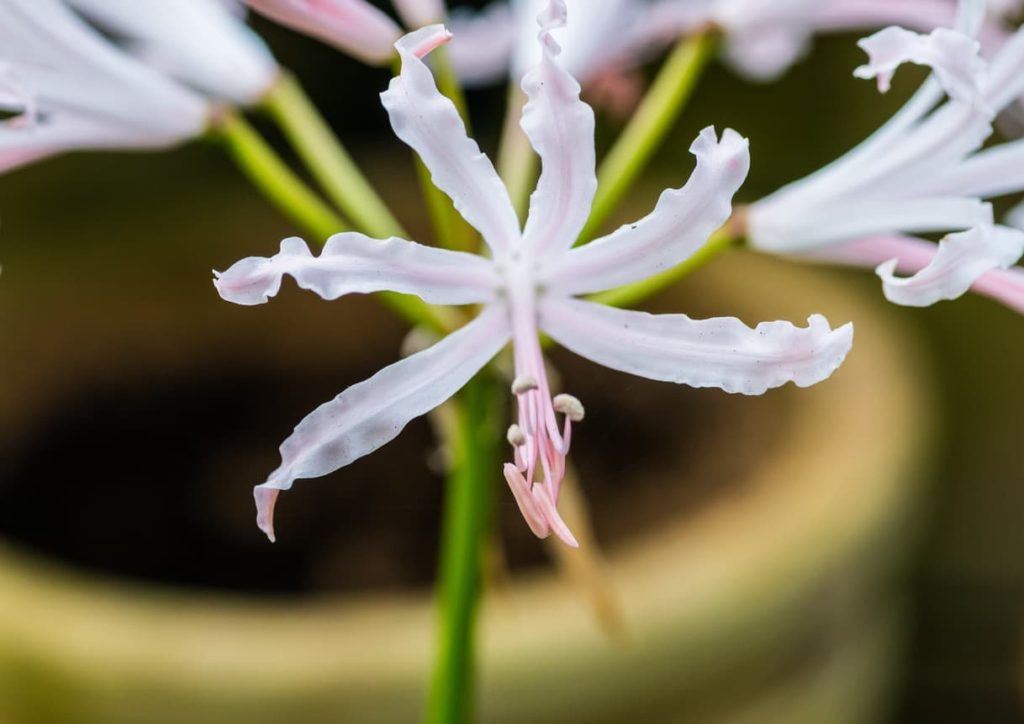
N. bowdenii ‘Alba’ has white star-shaped flowers and is excellent for use with other types of Guernsey lilies.
It looks great either in a container, border or garden bed; you can also cut them to display in a vase if you want.
Alba plants are hardy, so you don’t have to worry about them being exposed to wind/frost etc. in winter.
You should plant them in soil that’s well-drained and in a spot that gets good exposure to the sun.
N. undulata
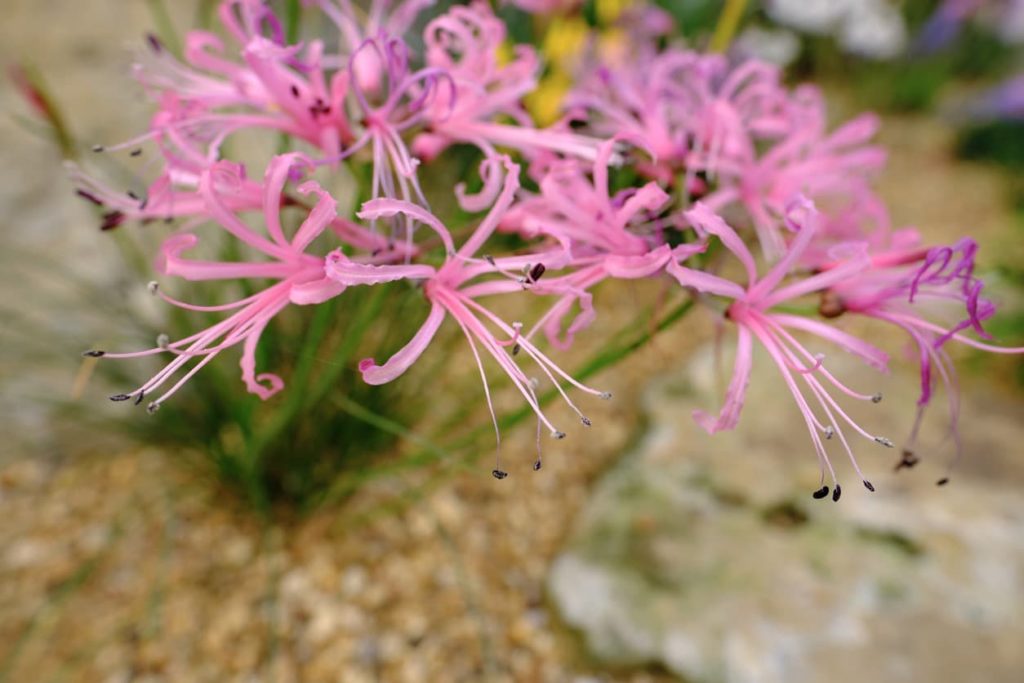
N. undulata is another beautiful variety and would be perfect planted in a sunny border, providing it gets some shelter later in the day.
It will generally do best in soil that’s not too saturated.
Guernsey Lily Benefits
Below are some of the main benefits of growing these plants –
- They help to add colour and interest to your garden.
- They’re suitable for being planted in flower beds as well as pots and containers.
- They’re completely hardy, so you don’t have to worry about them getting damaged or dying during harsh weather conditions in the winter.
- They generally don’t suffer from any diseases or pests.
- They can be bought very easily.
- They are very easy to grow.
- They look great when planted together in bunches.

How To Grow Nerine
You have the option to grow Guernsey lilies either directly in the soil of a flower bed or border; or in containers.
They do well in either growing method providing they get enough water and sunlight.
“I would recommend growing nerines in a glasshouse or a frost-free greenhouse,” says Nick.
“They like square, plastic 2-litre pots for the most successful flowering. I’ve found that this also is the best choice for their annual root development.”
Container Growing
Growing Guernsey lilies in pots or containers is quite simple, but it’s important you take the right steps at the beginning to make sure they flower well.
The first step is to fill your container with soil.
You don’t need to be too particular about the condition or the pH of the soil; providing it’s not too moist it will be fine.
Dig a hole in the soil and place the bulb in it, leaving an inch above the top of it.
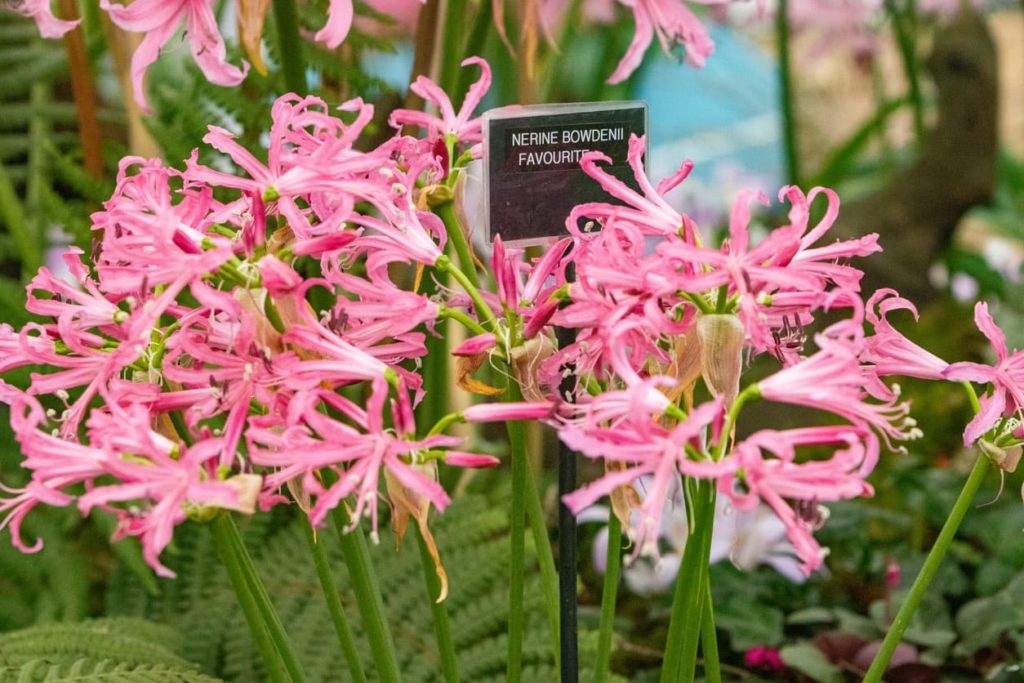
If you’re planting multiple bulbs in the same container, then you should leave roughly 8-10 inches between them, so they have enough room to grow.
In the UK climate, it’s usually okay to leave potted Guernsey lilies on a windowsill.
This way you can ensure it gets a good amount of sunlight during the day and shade in the evening.
Make sure to water the plants generously when you notice they’re growing.
However, “don’t over water, as waterlogging will cause the bulbs to rot,” warns Caroline.
“In the greenhouse, withhold water from N. sarniensis when they go dormant and wait until signs of growth (usually in August in the UK) before starting to water again.”
You should notice foliage first beginning to appear in the spring and summer, with the flower stems appearing in autumn.
Flower Beds & Borders
When you’re planting Guernsey lilies in a flower bed, the same basic planting procedure mentioned above should be used.
The most important part of planting Guernsey lilies outdoors is that you find the right spot for them.
“If you live in coastal areas of southern or western UK, you probably have mild enough winters to grow nerines outside all year round,” says Horticulturist Colin Skelly.
“I grow them at the base of south-facing walls. They flower best when they form clumps, declining only when they become tightly overcrowded (when they should be divided).”

The soil where you plant them should drain well and not be susceptible to waterlogging.
Nick recommends Johns Innes No. 3 for nerine bulb planting.
If water gathers in the soil hours after a downpour, you should find another spot.
Dig holes in the soil where you want to place your bulbs and plant them with the necks roughly an inch above soil level, as Caroline explains:
“Hardy nerines (mostly N. bowdenii) are very easy to grow but you must remember to plant them so the neck of the bulb shows above the ground.”
Again, if you’re planting multiple bulbs, then just be sure to leave enough space between them.
Water them well after planting, as well as during dry spells and when you notice new growth.
Planting Bulbs
The best time to plant Guernsey lilies is in spring.
Planting the bulbs at this time will give them plenty of time to get established, with the first signs of growth appearing in early autumn.
Nerine Care & Maintenance
Generally, Guernsey lilies are very hardy and can cope well with harsh conditions.

Still, it’s not a bad idea to use mulch in the winter to prevent the soil from becoming frozen and cracking.
It’s also important to avoid moving your lilies once they’ve been planted.
Guernsey lilies don’t cope well with being disturbed, so you should avoid doing this unless completely necessary.
It’s a good idea to add some bulb food or fertiliser when you first plant Guernsey lily bulbs as this will help to encourage growth.
“Remember to divide clumps of hardy nerines when they get congested,” Caroline advises.
“This will give you more bulbs to spread around your garden!”
Common Problems
One of the many great things about Guernsey lilies is that they’re not nearly as prone to diseases and pests as a lot of other plant species; in fact, they’re generally considered to be disease-free.
Although Guernsey plants are very hardy and resistant to diseases and pests, this doesn’t mean they’re completely problem-free.
“Tender nerines (N. sarniensis) need to be given winter protection such as a greenhouse – and you also need to watch out for mealybugs, which can be an issue in greenhouses,” says Caroline.
“A systematic bug killer can be applied in August whe root growth is active to get rid of mealybugs,” adds Nick.

One problem that Guernsey lilies can suffer from is not flowering.
This is usually because proper care hasn’t been taken to provide the plants with the best environment.
Some rules to adhere to if you want them to flower are –
1) Plant Them In Good Soil
Although Guernsey lilies are hardy plants, it’s still necessary to ensure they’re planted in soil that’s in decent condition.
Soil that’s very dry and cracked or overly saturated should be avoided.
2) Allow Enough Room For The Bulb When Planting
You’ll certainly want to ensure that you leave enough room when planting the bulb so it’s able to grow.

Dig a hole in the soil and when placing the bulb in it, leave the top of bulb roughly an inch above soil level.
3) Water Regularly
In the months after you first plant Guernsey lily bulbs, it’s vital that you make sure you water them regularly.
How much you need to water your bulbs will depend on the weather and where they’re planted.
If you have them in pots, then soaking them once every couple of weeks will work well.
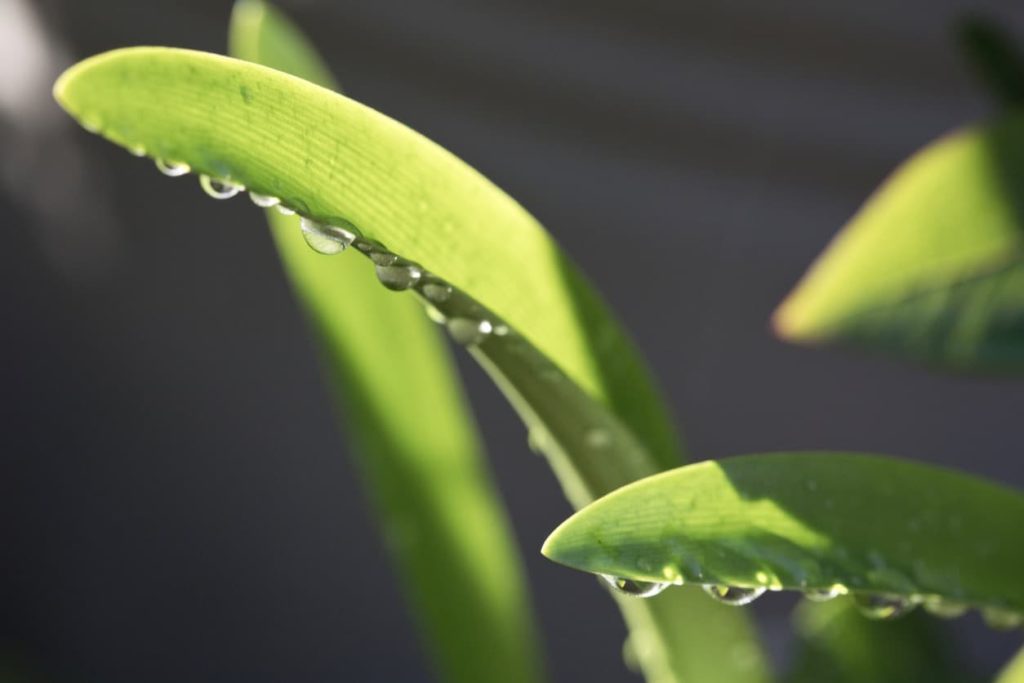
If your bulbs are planted outdoors, then you should water your plants after they’re first planted, during dry spells and when you notice any new flowers emerging.
“You can also feed during the growing period with a weak tomato fertiliser,” Nick suggests.
4) Make Sure They Get Plenty Of Sunlight
Sunlight is equally important for Guernsey lilies as water.
You should place any plants that you have in a spot where they’ll get plenty of sunlight during the day.
If you put your bulbs in pots, then you should place them on a windowsill or somewhere else where they can get sunlight.
Outdoor plants should be planted in a spot where they get at least some sunlight during the day.
FAQs
Are Guernsey Lilies Hardy Plants?
Yes. Guernsey lilies are completely hardy, which means they’re able to cope during the harsh winters in the UK.
Why Do My Guernsey Lilies Not Flower?
If you find that your Guernsey lilies aren’t flowering, then this is often because they’re grouped too closely together.

If you want them to thrive, then it’s a good idea to leave a good amount of space between each plant, usually around 8-10 inches.
What Are The Best Conditions To Grow Guernsey Lilies In?
Guernsey lilies do best when they get a good mix of sunlight and water.
This means you should ideally place them in light shade and ensure the soil where they’re planted is watered regularly.
Using mulch is a good way to retain the moisture in the soil to make sure they don’t dry out.
Do You Need To Use A Certain Type Of Soil Or Compost With Guernsey Lilies?
It’s not necessary to purchase a certain type of compost to use with Guernsey lilies since they’re able to do well in most conditions.

Providing you ensure the soil is in decent condition and isn’t overly dry or saturated, they should be fine.
Should You Use Fertiliser When Planting?
It’s not a bad idea to add a small amount of fertiliser or bulb feed to the soil when you’re first planting Guernsey lily seeds.
It will help them to grow at a healthy rate.
References
- 1Nerine. (n.d.-b). Kew Royal Botanic Gardens. Retrieved March 16, 2023, from https://powo.science.kew.org/taxon/urn:lsid:ipni.org:names:1561-1
- 2Nerine. (n.d.-c). Royal Horticultural Society. Retrieved March 16, 2023, from https://www.rhs.org.uk/plants/nerine
- 3Nerines. (2009, September 18). The Northern Echo. Retrieved March 16, 2023, from https://www.thenorthernecho.co.uk/opinion/latest/4636850.nerines/

